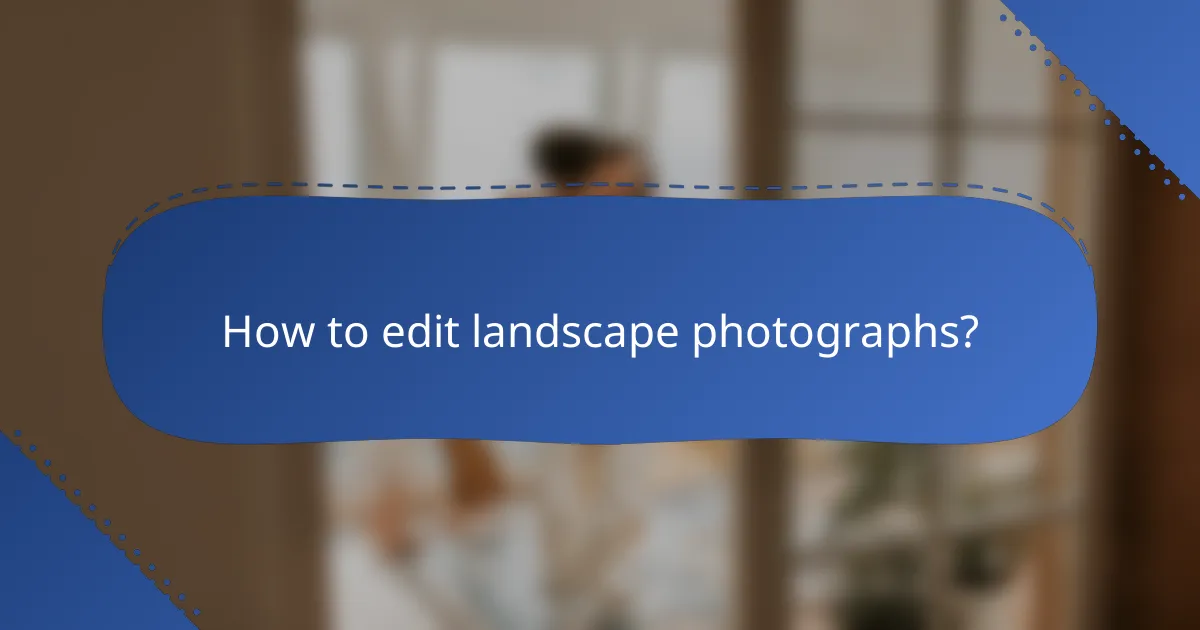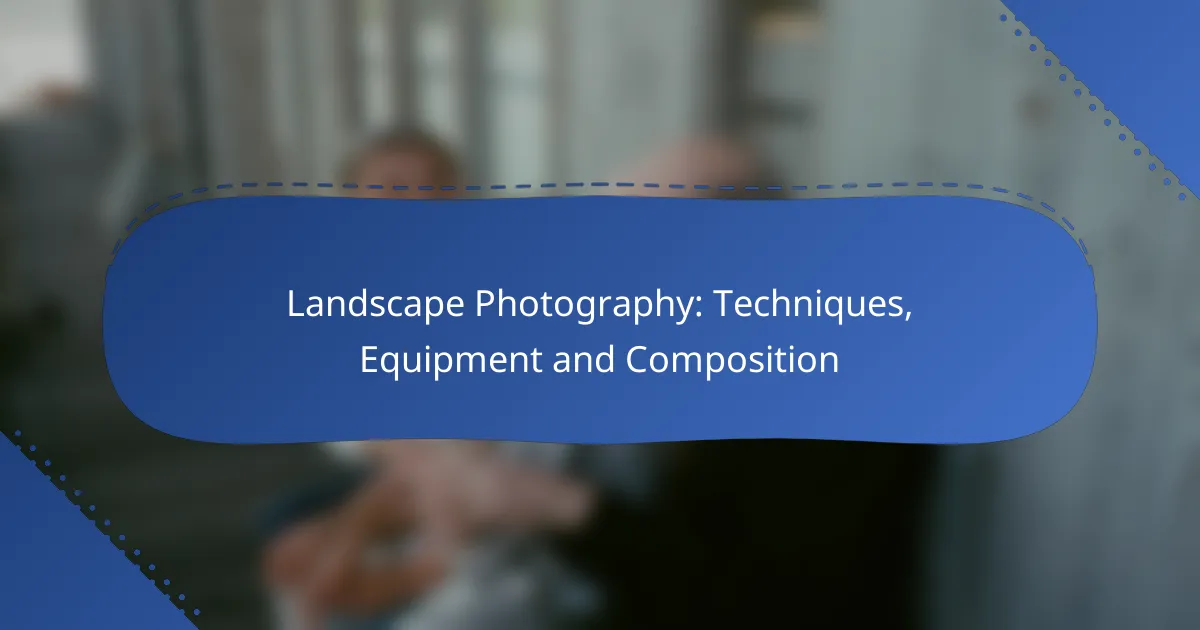Landscape photography is an art that combines technical skill with a keen eye for composition, enabling photographers to capture the beauty of nature. Mastering techniques such as long exposure and shooting during the golden hour, along with using the right equipment, can elevate your images. Additionally, understanding composition principles helps create visually striking photographs that draw viewers in and convey the essence of the landscape.

What are the best techniques for landscape photography?
The best techniques for landscape photography include long exposure, shooting during the golden hour, using leading lines, layering elements, and high dynamic range imaging. Each technique enhances the visual impact of landscapes, allowing photographers to capture stunning and dynamic images.
Long exposure techniques
Long exposure techniques involve using a slow shutter speed to capture motion and light over an extended period. This method is particularly effective for creating smooth water surfaces or capturing the movement of clouds. A good starting point is to use shutter speeds ranging from a few seconds to several minutes, depending on the desired effect.
When using long exposure, consider using a tripod to stabilize your camera and prevent unwanted blur. Neutral density filters can also help by reducing the amount of light entering the lens, allowing for longer exposures even in bright conditions.
Golden hour shooting
Shooting during the golden hour, which occurs shortly after sunrise and before sunset, provides soft, warm light that enhances landscape photography. This natural lighting creates dramatic shadows and highlights, making colors more vibrant. Aim to shoot within the first hour after sunrise or the last hour before sunset for optimal results.
To make the most of golden hour, plan your shoots in advance and arrive early to set up. This time of day can also lead to rapidly changing light conditions, so be prepared to adjust your camera settings quickly.
Use of leading lines
Leading lines are compositional elements that draw the viewer’s eye into the photograph. These lines can be natural features like rivers, roads, or pathways that guide the viewer’s gaze toward the main subject. Incorporating leading lines can create depth and perspective in your landscape images.
When composing your shot, look for lines that lead from the foreground to the background. Experiment with different angles and positions to find the most effective way to utilize these lines in your composition.
Layering elements
Layering elements in landscape photography involves including multiple foreground, middle ground, and background elements to create depth and interest. This technique helps to convey a sense of scale and can make the image more engaging. Consider incorporating trees, rocks, or other features in the foreground to add dimension.
To effectively layer elements, use a wide aperture to create a shallow depth of field, or a smaller aperture for greater depth. Experiment with different focal lengths to see how they affect the perception of layers in your composition.
High dynamic range imaging
High dynamic range (HDR) imaging is a technique that combines multiple exposures to capture a wider range of light and detail in both shadows and highlights. This is particularly useful in landscapes where lighting conditions can vary significantly. To create an HDR image, take several shots at different exposures and blend them in post-processing.
When shooting for HDR, use a tripod to keep the camera stable between shots. Make sure to cover a range of exposures, typically from underexposed to overexposed, to ensure you capture all details. Be cautious with HDR processing, as overdoing it can lead to unnatural-looking images.

What equipment is essential for landscape photography?
Essential equipment for landscape photography includes a reliable camera, suitable lenses, and accessories that enhance stability and control over light. Investing in quality gear can significantly improve the results of your landscape shots.
DSLR vs. mirrorless cameras
Both DSLR and mirrorless cameras can produce stunning landscape photographs, but they have distinct advantages. DSLRs typically offer longer battery life and a wider selection of lenses, while mirrorless cameras are generally lighter and provide real-time exposure previews.
When choosing between the two, consider your shooting style and preferences. If you prioritize portability and advanced features, a mirrorless camera may be the better choice. Conversely, if you prefer a traditional feel and extensive lens options, a DSLR could suit you well.
Wide-angle lenses
Wide-angle lenses are crucial for capturing expansive landscapes, as they allow you to include more of the scene in your frame. Lenses with a focal length of 16-35mm are popular among landscape photographers for their ability to create a sense of depth and perspective.
When selecting a wide-angle lens, look for one with minimal distortion and good sharpness. Prime lenses often provide better image quality than zooms, but a versatile zoom lens can be more practical for varying compositions.
Tripods for stability
A sturdy tripod is essential for landscape photography, especially in low-light conditions or when using long exposure techniques. It helps eliminate camera shake, ensuring sharp images and allowing for longer shutter speeds without blurring.
When choosing a tripod, consider its weight, height, and stability. Carbon fiber tripods are lightweight and durable, making them ideal for hiking, while aluminum tripods are often more affordable but heavier. Ensure the tripod can support your camera and lens combination securely.
Filters for light control
Filters are valuable tools for landscape photographers, helping to manage light and enhance image quality. Neutral density (ND) filters allow for longer exposures by reducing the amount of light entering the lens, which is useful for creating smooth water effects or motion blur in clouds.
Polarizing filters can reduce glare and enhance colors, particularly in skies and foliage. When using filters, be mindful of potential vignetting, especially with wide-angle lenses, and ensure they are compatible with your lens size.

How to compose landscape photographs effectively?
Effective composition in landscape photography involves arranging elements within the frame to create a visually appealing image. Key techniques include using the rule of thirds, framing techniques, and balancing elements to guide the viewer’s eye and enhance the overall impact of the photograph.
Rule of thirds application
The rule of thirds is a fundamental guideline that divides the image into a grid of nine equal parts, with two horizontal and two vertical lines. Placing key elements along these lines or at their intersections can create a more dynamic composition. For instance, positioning the horizon along the top or bottom third can emphasize either the sky or the land.
To apply this rule effectively, visualize the grid before taking the shot. Experiment with different placements of focal points, such as trees or mountains, to see how they interact with the surrounding space. This technique often results in a more balanced and engaging photograph.
Framing techniques
Framing techniques involve using natural elements within the scene to create a ‘frame’ around the subject. This can include trees, arches, or even pathways that lead the viewer’s eye toward the focal point. By incorporating these elements, you can add depth and context to your landscape images.
When using framing, ensure that the frame does not overpower the subject. Adjust your angle and distance to find a composition where the frame enhances rather than distracts. This technique works well in various environments, from forests to urban landscapes.
Balancing elements
Balancing elements in a landscape photograph helps create harmony and stability within the composition. This can be achieved by distributing visual weight evenly across the frame, ensuring that no single area feels too heavy or empty. For example, if you have a large mountain on one side, consider placing a smaller element, like a tree or a rock, on the opposite side.
To achieve balance, consider the colors, shapes, and sizes of objects in your scene. Use contrasting elements to draw attention and create interest. A well-balanced photograph feels cohesive and guides the viewer’s eye smoothly throughout the image.

What are the prerequisites for successful landscape photography?
Successful landscape photography requires a solid understanding of exposure settings and knowledge of weather conditions. Mastering these elements can significantly enhance the quality of your images and help you capture stunning landscapes.
Understanding exposure settings
Exposure settings determine how light interacts with your camera sensor, affecting the brightness and detail of your photographs. Key components include aperture, shutter speed, and ISO, which work together to create the desired exposure.
Aperture controls the amount of light entering the lens; a lower f-stop number (like f/2.8) allows more light, while a higher number (like f/16) lets in less. Shutter speed, measured in seconds or fractions of a second, dictates how long the sensor is exposed to light. A faster shutter speed (e.g., 1/500s) freezes motion, while a slower speed (e.g., 1s) can create a smooth effect in moving water.
ISO sensitivity affects the sensor’s response to light. A lower ISO (100-200) is ideal for bright conditions, while a higher ISO (800-1600 or more) is useful in low light but may introduce noise. Balancing these settings is crucial for achieving the best results in landscape photography.
Knowledge of weather conditions
Understanding weather conditions is essential for landscape photography, as they can dramatically influence the mood and quality of your images. Factors such as light, cloud cover, and atmospheric conditions play a significant role in the final outcome.
Golden hour, shortly after sunrise or before sunset, offers soft, warm light that enhances landscapes. Overcast days can provide even lighting, reducing harsh shadows, while dramatic weather, like storms or fog, can add a sense of drama and depth to your photos. Always check local weather forecasts and be prepared for changing conditions.
Additionally, consider the season and its impact on the landscape. For instance, autumn foliage can provide vibrant colors, while winter may offer stark contrasts with snow-covered scenes. Tailoring your approach based on the weather can lead to more compelling photographs.

How to edit landscape photographs?
Editing landscape photographs involves adjusting various elements to enhance the image’s overall appeal and clarity. Key techniques include color correction, cropping, and sharpening to bring out the best in your landscape shots.
Color Correction
Color correction is essential for achieving accurate and vibrant colors in landscape photography. Use software tools to adjust white balance, saturation, and contrast, ensuring that the colors reflect the scene as you experienced it. Pay attention to the skies and foliage, as these areas often require specific adjustments to avoid unnatural hues.
Consider using presets or filters as starting points, but always fine-tune them to match your vision. A common practice is to increase saturation slightly for landscapes, but avoid overdoing it to maintain realism.
Cropping and Composition
Cropping can significantly improve the composition of a landscape photograph. Focus on the rule of thirds by positioning key elements along the grid lines or at their intersections. This technique helps create a balanced and engaging image.
When cropping, be mindful of the original aspect ratio. For social media, a square or vertical crop may be more effective, while a wider landscape might suit print formats better. Always keep the main subject in focus and eliminate distracting elements from the frame.
Sharpening and Noise Reduction
Sharpening enhances the details in your landscape photographs, making them appear crisper. Apply sharpening selectively, focusing on areas that should draw the viewer’s attention, such as mountains or trees. Over-sharpening can lead to unnatural artifacts, so use this tool judiciously.
Noise reduction is particularly important for images taken in low light or at high ISO settings. Use noise reduction tools to smooth out graininess while preserving detail. A good balance is crucial; aim for a clean image without losing texture in important areas.
